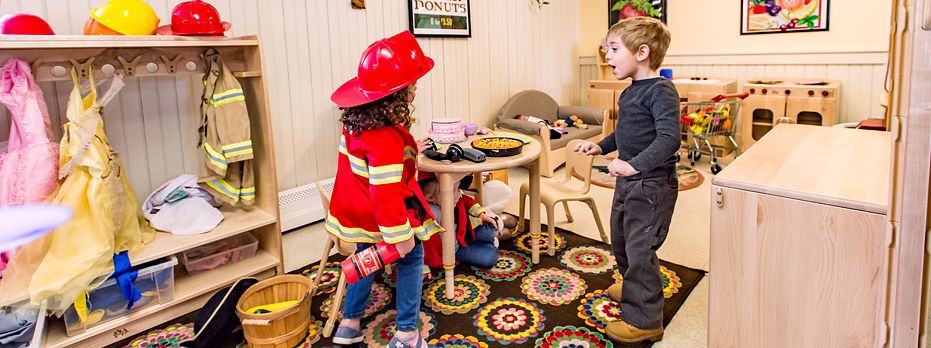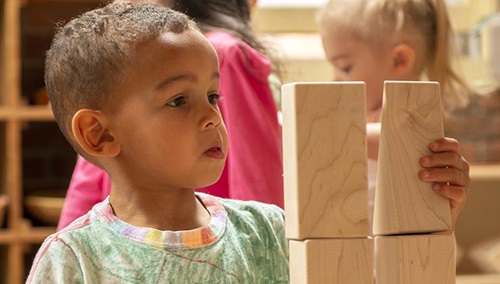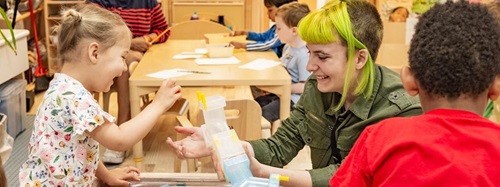Confirmed by Research
Pretend Play Links to Self-Regulation and Learning in Young Children.
|
November 2013
The study of early childhood education has produced some extraordinary findings as of late. Many tenets of early childhood that we previously just knew or had a gut-level feeling for, now have research to confirm these beliefs. For example, I have fond memories of my mother reading to me. When I asked my mother how I learned to read, she said that I used to sit on her lap and she would read to me the same books over and over again; and before she knew it, I was reading. She enjoyed reading to me and “just felt” that the activity had to be good for children. Many parents even today would agree. Now, however, we have research to confirm that one of most important things that parents can do to help their children become ready for kindergarten and to learn to read is to read aloud to them. Similarly, research now shows that pretend play is not something children do just to have fun or pass the time, but is the foundation for future learning.
Another gut-level tenet of education is that children need to have mastered self-control in order to be successful in school. A child must be able to stay seated and stay quiet while the teacher is talking. A child needs to be able to line up and walk to various places in the school without hitting the neighbor in line with him/her or running ahead of the group. A child needs to wait his/her turn and learn that everyone cannot be first at the same time or all the time. A child needs to learn that there are winners and losers. A child needs to able to independently stay on task and complete the work assigned to him/her without be distracted or begging for help. Self-control, recent research has found, is part of a larger group of skills called executive functioning. This research confirms that executive functioning is absolutely necessary for success in school and later life, as well.
The most exciting finding today for early childhood education is in the area of brain research. With the help of MRI (magnetic resonance imaging) of the brain, we know that pretend play helps develop that part of the brain that enables a child to have executive functioning skills which in turn leads to learning. Children who have ample opportunities to practice pretend play have higher test scores in both reading and math. Pretend play and executive functioning are linked to numerous other outcomes such as increased language and communication skills, increased creativity and problem solving skill, and increased ability to take perspective of others, to engage in critical thinking, to making connections, to taking on challenges, and to becoming an engaged, self-directed learner. No more mere “gut-feelings” that pretend play is good for children, brain research proves it.
So, with all this research about the link among pretend play, learning, and brain growth and executive functioning, why is play being eliminated in Kindergarten and PreK classrooms in America?
Recent School Trends and Why People View Play Negatively
Here are a few reasons and recent trends that contribute to the lack of play in early childhood classrooms and, consequently, a negative view of play:
- Politicians and many school leaders lack knowledge of child development and how children learn
- Politicians and school leaders want higher test scores and accountability and the way to get there is direct instruction
- Accountability leads to testing and more testing and then “teaching to the test”
- Teaching to the test is drill and re-drill of facts, not true learning; in reality there is no research to support the practice of drilling facts
- Merit pay based on children’s test scores
- Push-down curriculum—the sooner is better phenomenon, Kindergarten is the “new” first grade
- Common Core Standards—teaching to the standard rather than using them as outcome guidelines
Most politicians, school leaders, and even parents think there is no time for play at school because children need to be busy learning! “Play is under siege!” say Edward Zigler. Given the importance of the first years of life, do we have time to ignore the importance of play in the early childhood classroom?
The Brain and Executive Functioning
New brain research on the development of the prefrontal cortex of the brain, primary home of executive functioning skills (EF), is dominating discussions of early childhood practice. Stanislas Dehaene of the College de France in Paris calls this front and center part of the brain a “neuronal workspace [whose] primary purpose is to “assemble, confront, recombine, and synthesize knowledge [so that] our behavior is guided by a combination of information from past or present experience.” Executive functioning consists of:
Self-control: Ability to inhibit a dominant response in favor of a less salient one.
Working memory: Ability to hold information and recall it when necessary.
Cognitive Flexibility: Ability to change and adjust mental effort.
The research conducted by the Tools of the Mind authors, Deborah Leong and Elena Bodrova, on the development of EF during pretend play with other children is quite compelling. Tools of the Mind (TOM) curriculum is a play-based literacy program for PreK and Kindergarten children. During the first half of the year, the curriculum is mainly focused on helping child learn to play and helping children stay in their role for up to 45 minutes of pretend play. In the second semester developmentally appropriate instruction is woven into the day. When compared to the control group who received traditional instruction all year long, the TOM children scored significantly higher on both language and math standardized testing.
Even more convincing is the long term benefits of pretend play and executive functioning skills. Research on reading comprehension of middle school students found that children, who could read (decode) but could not comprehend what they were reading, lacked executive functioning development. When researchers reviewed MRI’s of the brain of these “non-comprehend-ers” compared to normal reading brains, it was obvious that the prefrontal cortex of the readers had significantly much more development! Pretend playing in PreK and Kindergarten leads to reading comprehension in older children.
Another amazing discovery in the research on executive functioning is that some researchers are finding that EF is a better predictor of academic success than IQ. A classic study from1968 by Professor Walter Mischel, a groundbreaking psychologist in the field of self-control and will power, enlisted the use of a simple test, called the Marshmallow Test, to discover how much self-control (or EF) a child may or may not have. A 3-6 year old child is brought into an examining room and given one marshmallow on a plate. He/she is told that he/she “can eat the one marshmallow now or wait here until I return and you can have two marshmallows to eat.” The researcher then leaves for 15 minutes. Some children eat the marshmallow right away, some nibble at little pieces or lick the marshmallow, but some children can wait the full 15 minutes using a variety of strategies to deter them from eating. Those that can wait are showing self-control skills and strengthening their executive functioning skills. They can delay gratification—an essential skill in just about everything an adult does. This study also found that by studying those same children over time that those children with higher amounts of the executive functioning area had SAT Scores 210 points higher than those with less executive functioning as children!
In a more recent study that measured levels of executive function of 1,037 New Zealand children, by following the children up into their teenage years and adulthood, it was found that children who could better regulate their impulses and attention were four times less likely to have a criminal record, three times less likely to be addicted to drugs and half as likely to become single parents. In many dimensions of successful, healthy living, the level of executive functioning was more predictive of adult outcomes than either IQ scores or socioeconomic status. Executive functioning skills have lasting adult benefits.
Play and Learning
“I hear and I forget. I see and I remember. I do and I understand.” Chinese Proverb
Young children, birth to age eight years, learn best through play. What does this mean exactly for the educator, administrator, and politician? What does this “play” look like? Is it all “play-time?” How much “play?” Is all “play” the same?
There are many types of play in a quality PreK and Kindergarten classroom. The following chart is a brief overview of what children learn through different kinds of play in a typical classroom.
Type Of Play |
Classroom Center |
What Children Learn |
Construction play |
Blocks, building |
Math concepts |
Creative play |
Easel painting |
Science of color, shape, design |
Manipulative play |
Beads, beans, junk |
Sorting, classifying, fine motor |
Sand and water play |
Sand/water table or outdoors |
Texture, volume, science |
Exploratory play |
Language/library/writing center |
Use of symbols on paper |
Gross motor/active play |
Running, climbing, throwing |
Large muscle development |
Language play |
Banana, nana, fo, fo…… |
Rhyming words |
Music play |
Instruments |
Rhythm, beat, |
Group/game play |
Duck duck goose |
Rules, one-to-one correspondence, taking turns |
Dramatic play |
Acting out a story |
Recall, sequence of story, vocabulary |
Socio-dramatic play* |
Spontaneous acting out a situation/event |
Language, creativity, rules, roles, flexibility, self-control, perspective |
*Mature, sustained socio-dramatic play is the most important type of play. This is when executive functioning develops.
In addition to knowing how play helps children learn, all adults who work with children must understand the basic principles of child development. Arnold Gesell (1880-1961) was a ground-breaking researcher of child development. Gesell found that all children go on the same path of development; however, some go faster, some go slower, and all have spurts and set-backs along the way. The obvious example is the age that children learn to walk. Some children learn to walk as early as nine months, some as late as 15 months. But that is all normal and we all agree that the early walker is not a better walker than the later walker. The Gesell message to educators is that each child has his/her own pace on the path of development and that pace must be respected in the classroom. Knowing where the child is on the path of development informs instruction for that child. Knowing how to plan a play-based curriculum respects the child and child development.
As we plan our programs for young children, we cannot ignore these important new findings from research that are linking self-regulation and executive functioning with pretend play and learning in young children. Some of the findings confirm what we always knew, but some of the new research is so compelling that it would be a disservice to children not to “listen, see, and do” what this research is telling us. Children need to play in order to develop to their fullest capacity as learners and as members of society.
References:
Almon, J., & Miller, E. (2011). The crisis in early education: A research-based case for more play and less pressure. College Park, MD: Alliance for Childhood.
Almond, B. (2010). The value of knowledge. In R. Bailey (Ed.), The SAGE Handbook of Philosophy of Education. (Vol. 1, pp. 297-308). London: SAGE Publications.
Brown, S. L. (2009). Play: How it shapes the brain, opens the imagination, and invigorates the soul. New York, NY: Avery, Penguin Group.
Copple, C., & Bredekamp, S. (2009). Developmentally appropriate practice in early childhood programs: Serving children from birth through age 8. Washington, DC: National Association for the Education of Young Children.
Diamond, A., Barnett, W. S., Thomas, J., & Munro S. (2007). Preschool program improves cognitive control. Science, 318, 1387-1388.
Erikson, E. H. (1950). Childhood and society. New York, NY: Norton.
Freud, S. (1955). Analysis of a phobia in a five-year-old boy. In J. Strachey (Ed.), The standard edition of the complete psychological works of Sigmund Freud (Vol. 10, pp. 1-147). London: Hogarth Press. (Original work published 1909).
Galinsky, E. (2010). Mind in the making: The seven essential life skills every child needs. New York, NY: HarperCollins Publishers.
Gesell, A. (1925). The mental growth of the pre-school child: A psychological outline of normal development from birth to the sixth year, including a system of developmental diagnosis. New York, NY: Macmillan.
Gilliam, W., & Shahar, G. (2006). Prekindergarten expulsion and suspension: Rates and predictors in one state. Infants and Young Children, 19, 228-245.
Groos, K. (1898). The play of animals. New York, NY: Appleton.
Hall, G. S. (1906). Youth: Its education, regiment, and hygiene. New York, NY: Appleton.
Heckman, J. J. (2012). Building a productive workforce and strong economy from birth. [PowerPoint slides]. Retrieved from www.heckmanequation.org/download.php?file=F_031412MontereyHeckmanLecture_SlidesNotes_0.pdf.
Kagan, S. L., & Lowenstein, A. E. (2004). School readiness and children’s play: Contemporary oxymoron or compatible option? In Children’s play: The roots of reading (pp. 59-76). Washington, DC: Zero to Three.
Leong, D. J., & Bodrova, E. (2012). Assessing and scaffolding: Make-believe play. Young Children, 67(1), 28-34
National Association of Elementary School Principals. (2013). Principals need to know about early childhood development. Watertown, MA: Charlesbridge Publishing.
Moffitt TE, Arseneault L, Belsky D, Dickson N, Hancox RJ, Harrington H, Houts R, Poulton R, Roberts BW, Ross S, Sears MR, Thomson WM, Caspi A. (2011). A gradient of childhood self-control predicts health, wealth, and public safety. Proceedings National Academy of Sciences, U S A.,108(7):2693-8.
Patrick, G. T. W. (1916). The psychology of relaxation. New York, NY: Houghton Mifflin.
Piaget, J. (1966). Mental imagery in the child: A study of the development of imaginal representation. London, England: Routledge and Kegan Paul.
Pink, D. H. (2009). A whole new mind. New York, NY: Penguin Group.
Sesma, H. W., Mahone, M. E., Levine, T., Eason, S. H., & Cutting, L. E. (2009). The contribution of executive skills to reading comprehension. Child Neuropsychology, 15(3), 232-246.
Smilansky, S. (1968). The effects of sociodramatic play on disadvantaged preschool children. New York, NY: Wiley.
Tough, P. (2012). How children succeed: Grit, curiosity, and the hidden power of character. New York, NY: Houghton Mifflin Harcourt.
Trentacosta, C. J., & Izard, C. E. (2007). Kindergarten children’s emotion competence as a predictor of their academic competence in first grade. Emotion, 7(1), 77.
Zigler, E., & Bishop-Josef, S. J. (2004). Children’s play: The roots of reading. Washington, DC: Zero to Three.







